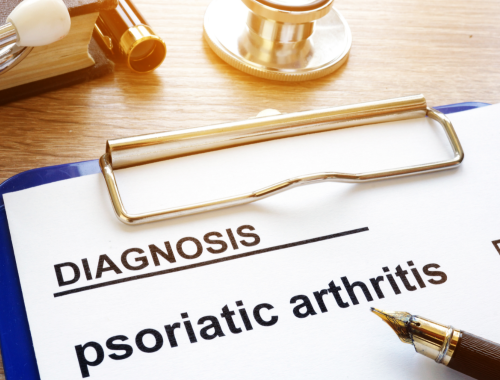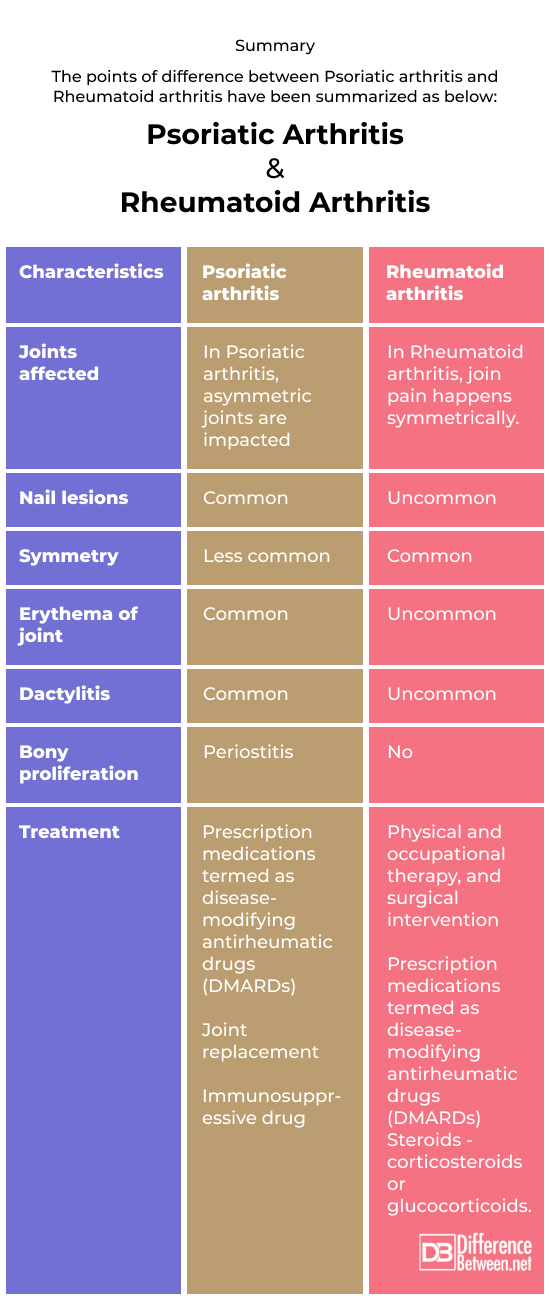Difference Between Psoriatic Arthritis and Rheumatoid Arthritis

When you have Rheumatoid arthritis, the tissues (layer of cells doing a specific function) lining the joints are fiercely attacked by your immune system. They swell up and become uncomfortable. They are susceptible to damage and deformation over time. In Psoriatic arthritis, the immune systems attacks and damages not only the joints but the nails and skin as well.

Similarity
Both are chronic inflammatory conditions and involve damage to the joints. Both conditions are often misdiagnosed.
Psoriatic arthritis
Some persons who have the arthritic disorder psoriasis experience psoriatic arthritis. Joint pain, stiffness, and edema that flares and subsides are its hallmarks. For those who have the syndrome, morning stiffness is typical. Significant arthritis can result from even modest skin psoriasis. Steroids, joint replacement surgery, or medications that reduce inflammation can all be used to treat the condition.
Rheumatoid arthritis
An autoimmune condition is rheumatoid arthritis. The immune systems often serve as a defense system and helps in safeguarding your body against any foreign attacks and illness and infection. When you suffer from rheumatoid arthritis, your immune system is compromised and it attacks healthy joint tissues.
Science does not have specific evidence as to how the process of rheumatoid arthritis begins. Even though your genes don’t directly cause rheumatoid arthritis, they can increase your susceptibility to the environmental conditions, such infection with specific viruses and bacteria, that may do so.
Difference between Psoriatic arthritis and Rheumatoid arthritis
Definition
Psoriatic arthritis
It is an inflammatory arthritis that mostly happens in people suffering from psoriasis.
Rheumatoid arthritis
It is a chronic inflammatory condition in which the body joints are primarily affected. It is usually common in hands and feet. In this kind of arthritis, the immune system attacks and targets its own tissue and in some severe cases, the internal organs as well.
Symptoms
Psoriatic arthritis
- Moving around in the morning is challenging
- Your fingertips resemble cooked sausages
- You get lower back ache
- Your nails are ridged and contain grooves
- Your eyesight is problematic
- You always feel exhausted
Rheumatoid arthritis
- High temperature
- Fatigue
- Bruised, heated, and tender joints
- Pain and discomfort worse in the mornings as there is lot of challenge in movements
- Joint stiffness
Distribution
Psoriatic arthritis
Ray pattern and DIP involvement
Rheumatoid arthritis
Row pattern, MCP and wrist involvement
Inflammatory lesions
Psoriatic arthritis
Enthesitis with adjacent synovitis, tenosynovitis, periarticular inflammation
Rheumatoid arthritis
Synovitis, tenosynovitis
Bone marrow edema
Blood tests
Psoriatic arthritis
Patients of psoriatic arthritis do not have protein called rheumatoid factor in their blood
Rheumatoid arthritis
Patients of rheumatoid arthritis have protein called rheumatoid factor in their blood.
X-rays
Psoriatic arthritis
Where ligaments (a band of tissue that connects bones, joints or organs) and tendons (a cord of strong, flexible tissue) join to bone, there is typically increased inflammation in psoriatic arthritis.
Rheumatoid arthritis
In Rheumatoid arthritis (RA) swelling (inflammation) can be seen in the joint lining.
Summary
The points of difference between Psoriatic arthritis and Rheumatoid arthritis have been summarized as below:

FAQ:
Is rheumatoid arthritis or psoriatic arthritis worse?
The pain, swelling and discomfort with psoriatic arthritis is worse and significant in comparison to the rheumatoid arthritis. You feel your bones are shattering and crumbling with psoriatic arthritis.
What are the six signs of psoriatic arthritis?
- Tiredness
- Lower back pain
- Nails get ridged and contain grooves
- Movement in the early mornings becomes difficult
- Your fingertips resemble cooked sausages
- Problematic eyesight
How do you confirm psoriatic arthritis?
Your doctor will make the diagnosis of psoriatic arthritis (PsA) by looking at your skin, nails, joints, and other symptoms. X-rays (type of radiation called electromagnetic waves), Magnetic resonance imaging (MRI), ultrasounds, and blood tests could all be performed on you as well to confirm PsA.
Where does psoriatic arthritis usually start?
Psoriatic arthritis usually starts in fingers, wrists, ankles and knees. Red skin lesions (plaques) topped with silvery scales start appearing.
Does psoriatic arthritis show up in blood work?
The results of blood tests can be used to identify illnesses that may be causing similar symptoms to psoriatic arthritis (PsA) or to rule them out. Routine blood tests are also used to monitor the progress of the disease and verify the effectiveness of your PsA treatment.
Can psoriatic arthritis be misdiagnosed as RA?
Particularly in a non-rheumatologic situation, Psoriatic Arthritis PsA is frequently undetected and might be mistaken for rheumatoid arthritis (RA) or osteoarthritis (OA).
What are the first red flags of psoriatic arthritis?
The first red flags of psoriatic arthritis include stiffness, joint pain, and edema.
What autoimmune disease causes psoriatic arthritis?
According to studies, some autoimmune illnesses are more common in psoriatic arthritis sufferers than in the general population. These include vitiligo (that causes the loss of skin color in blotches), thyroid autoimmunity (an illness caused by the immune system attacking healthy tissues), systemic lupus erythematosus (group of diverse, persistent autoimmune inflammatory diseases), and celiac disease.
What does a psoriatic arthritis flare feel like?
Fatigue is one of the early indicators of a Psoriatic arthritis flare, along with throbbing pain (intense pain), swelling (inflammation), and joint stiffness. The tendons (a cord of strong, flexible tissue) could also hurt. Patients suffering from psoriatic arthritis may also experience increasing skin complaints and swelling in the fingers and toes.
- Difference Between Global Warming and Greenhouse Effect - May 18, 2024
- Difference Between Vaccination and Immunization - March 3, 2024
- Difference Between Selective Mutism and Autism - February 25, 2024
Search DifferenceBetween.net :
Leave a Response
References :
[0]American College of Rheumatology Subcommittee on Rheumatoid Arthritis Guidelines. (2002). Guidelines for the management of rheumatoid arthritis: 2002 update. Arthritis & Rheumatism, 46(2), 328-346.
[1]Firestein, G. S. (2003). Evolving concepts of rheumatoid arthritis. Nature, 423(6937), 356-361.
[2]Ocampo, V., & Gladman, D. (2019). Psoriatic arthritis. F1000Research, 8.
[3]Ritchlin, C. T., Colbert, R. A., & Gladman, D. D. (2017). Psoriatic arthritis. New England Journal of Medicine, 376(10), 957-970.
